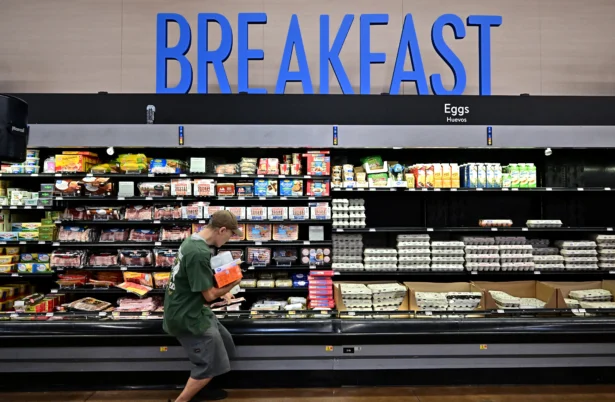The Federal Reserve’s preferred inflation gauge—the personal consumption expenditure (PCE) price index—came in below expectations, suggesting that the central bank is inching closer to its 2 percent target.
According to the Bureau of Economic Analysis (BEA), the PCE price index rose by 0.1 percent in August, down from the 0.2 jump in July.
The PCE decelerated to 2.2 percent year over year, down from 2.5 percent in the previous month.
Both readings came in below economists’ expectations.
The PCE showed that prices for goods tumbled by 0.9 percent from a year ago, and services surged by 3.7 percent. Food costs increased by 1.1 percent, and energy prices fell by 5 percent.
Omitting the volatile energy and food components, the core PCE also edged up at a lower-than-expected pace of 0.1 percent, down from 0.2 percent.
However, the core PCE index ticked up to 2.7 percent from the same month a year ago, up from 2.6 percent. This matched market forecasts.
The latest inflation data were mixed results for the Federal Reserve.
The updated September Summary of Economic Projections showed that officials anticipated that the median PCE inflation rate would be 2.3 percent by the year’s end and that the median core PCE rate would be 2.6 percent.
BEA data further highlighted that personal income and personal spending each rose at smaller-than-expected rates of 0.2 percent. Both were down from the July readings of 0.3 percent and 0.5 percent, respectively.
The personal saving rate as a percentage of disposable personal income dipped to 4.8 percent from 4.9 percent in July.
Inflation Expectations Moving Forward
The Cleveland Fed’s Inflation Nowcasting model anticipates that the annual PCE inflation rate will be 2.1 percent next month. Core PCE inflation is penciled in at 2.7 percent.
The next key inflation reading will be the September consumer price index (CPI). The annual inflation rate is forecast to ease to 2.3 percent, and core inflation is predicted to be 3.1 percent, according to the Cleveland Fed.
While the Federal Reserve slashed interest rates for the first time in more than four years and launched the next easing cycle with a jumbo 50-basis-point reduction, it might appear that the central bank has declared victory in vanquishing inflation from the U.S. economy.
However, monetary policymakers are not yet ready to say the job is finished.
“The goal is to have inflation move down to 2 percent on a sustainable basis,” Fed Chair Jerome Powell told reporters at the post-meeting press conference on Sept. 18.
“And we’re close, but we’re not really at 2 percent, and I think we’re going to want to see it be around 2 percent and close to 2 percent for some time, but … we’re not saying mission accomplished or anything like that.”

Fed Gov. Michelle Bowman was the lone dissenting vote at the September Federal Open Market Committee meeting, supporting a quarter-point rate cut.
Though she believes that it is time to reset monetary policy, Bowman says she favors a more conservative approach to the fresh easing cycle.
Speaking at the Mid-Size Bank Coalition of America Board of Directors Workshop in Dallas on Sept. 26, Bowman cited various upside risks to inflation that “remain prominent.” This includes aggressive fiscal policy, global supply chain disruptions, and the housing supply-and-demand imbalance.
“While it has not been my baseline outlook, I cannot rule out the risk that progress on inflation could continue to stall,” Bowman said.
“In light of these considerations, I believe that, by moving at a measured pace toward a more neutral policy stance, we will be better positioned to achieve further progress in bringing inflation down to our 2 percent target, while closely watching the evolution of labor market conditions.”
In an interview with CNBC, Fed Gov. Christopher Waller expressed concern that inflation could get too low after the softer-than-expected CPI and producer price index (PPI) reports earlier this month.
“Everybody was focused on core CPI, but what they weren’t, really, was looking at how that CPI report and the next day’s PPI report were going to feed into total core PCE inflation,” he stated. “What’s got me concerned is inflation is running softer than I thought.”
This is why Waller supported a half-point interest rate cut.
Chris Zaccarelli, the chief investment officer for Independent Advisor Alliance, says the Fed will likely continue cutting interest rates for the remainder of the year as long as inflation remains under control.
“To the extent that inflation remains under control—and we continue to trend in that direction—the Fed can focus almost entirely on the labor market, which means a rate-cutting bias,” he said in a note.
“As the Fed cuts rates—especially in the absence of recessionary growth—it is a great tailwind for both stock and bond markets and should eventually provide some relief for those consumers that are more interest-rate sensitive.”
The August annual inflation rate decelerated to 2.5 percent, below the consensus estimate of 2.6 percent. The PPI inflation rate also slowed to a lower-than-expected 1.7 percent.
The next two-day Fed policy meeting will occur on Nov. 6 and Nov. 7.
According to the CME FedWatch Tool, the futures market is split between a 25- and 50-basis-point rate cut.
From The Epoch Times

